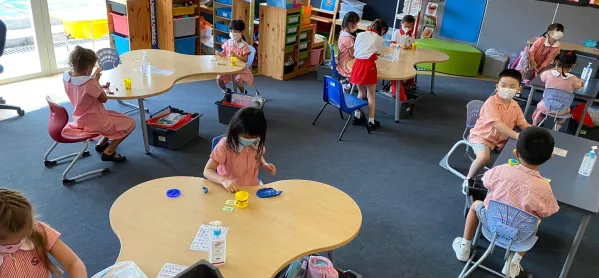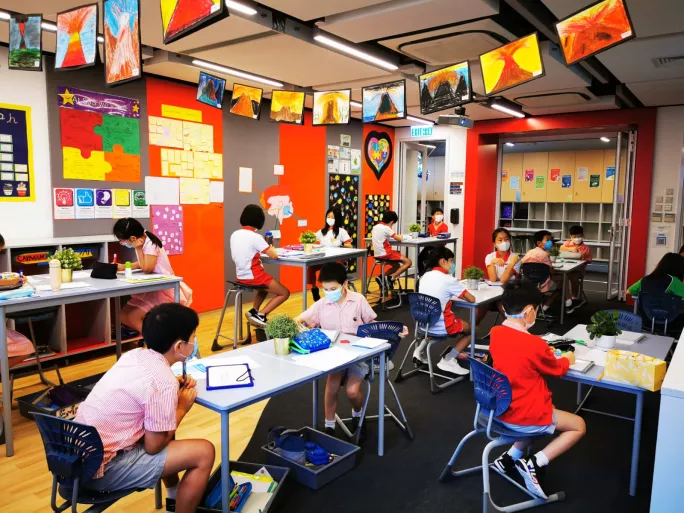- Home
- WATCH: ‘How we reopened our school in Hong Kong’
WATCH: ‘How we reopened our school in Hong Kong’

Around the world, schools have been opening at different stages, from Denmark in mid-April, to schools in England gearing up for a return on 1 June. In the end, it’s a fairly straightforward challenge: how do you get 900 students safely into a school that is operating at capacity - all of whom arrive at the same time and require their temperature checked - and get them into class while keeping them, at all times, at least a metre apart?
How do you allow them to eat lunch, to play at recess and to take part in PE, sport, art, dance and music?
And how do you do all of this while keeping a strong focus on their emotional wellbeing - and maintaining the morale and keeping a check on the wellbeing of your 121 staff? See, I told you it was straightforward. This is a challenge that more and more of us around the world will have to wrestle with as our governments take the decision to ease lockdown measures and start to reopen schools to students.
Coronavirus: Have Swedish schools really carried on as normal?
Schools reopening: The view from France
Easing lockdown: How Dutch schools reopened with no pupil distancing
Tes International podcast: Four weeks back in Denmark
Here in Hong Kong - and at ESF (English Schools Foundation), the largest provider of English medium international education in the city - that time was last week. After four months of school closure - and a comprehensive programme of online, at-home learning for all of our 18,500 students - it was time to throw open the gates once again.
As I write this, at the end of our first week back in school, I can hear children laughing, students shuffling along corridors and the unmistakable sound of an early years PE lesson taking place. I don’t need to get out of my chair and go and check - I know that social distancing is being impeccably observed.
So, how have we done it?
Well, the first thing to say is that one of the many advantages of working in a school system such as ours is that you can call on the brainpower of a lot of people. It was by drawing on the collective experience of my colleagues in our 22 schools - and the central support team - that we were able to design a solution.
And, like all good solutions, we found it by going back to basics - by finding those key principles that we could work to that would allow us to find the right answers.
For us, the key principles were threefold: firstly, we will keep everyone safe by strictly adhering to the guidelines published by the government. Secondly, we will not do anything that doesn’t support or enhance the learning experience of the students. Lastly, we would reopen together as a system, but we would retain the flexibility for schools to develop return to school plans that best reflected the needs of their community.
Once we had those in place, it was clear that the prospect of bringing every student back into school at the same time was, simply, unsustainable as a way forward. Having 900 children in school would not meet principle number one: there simply wasn’t the space.
Also, even if we were to somehow find a way to safely cram in all 900 students - presumably by ripping out every piece of furniture - we wouldn’t be able to deliver learning in a way that we know has the biggest impact. Students sitting in rows, unable to move for an entire day is not the way that we do our business.
So, we needed to think differently. We needed to find space.
Which is how we landed on the idea of “100 per cent of students learning, 50 per cent in school”. Simply put, we would create space by having only half of the school in at any one time. On the days that they weren’t in the building, students would continue learning using the online learning platforms that we had worked so hard to perfect.
This unlocked everything. It gave us the space to maintain social distancing, while also having room enough for us to safely deliver learning the way that we wanted to.
I’m aware that I am making this all sound very easy and, of course, it is not. Even with only half the children in school, we still needed to do all the things that made up our original challenge. We still had to get the students into school in an orderly manner, take their temperature and have them in classes, dining halls and sports pitches while maintaining social distancing.
Never has a metre stick been more useful.
In the days running up to the resumption of classes in school, we were literally walking about every part of the school with metre sticks, marking floors and moving furniture about. Every part of our school has signage - either on the wall or the floor - which helps students keep their distance.

Students have logbooks to keep a record of their temperature - both on the days that they are in school and at home - and we have strict protocols in place that govern what we do if someone shows signs of being unwell. It is only by looking at every detail that you can have confidence that nothing has been left to chance and that everyone will be safe and well in school.
And, of course, there are masks.
I know that there are endless debates about their usefulness - but here in Hong Kong, everyone wears one every day. It is insufferable at times - my face has never been hotter - but it has undoubtedly contributed to our city having one of the lowest infection rates in the world.
We are at the beginning of this period of ‘new normal’ - and none of us really knows what lies ahead. What I can tell you, though, is that by utilising the knowledge and experience of everybody in your school, you can safely reopen. You can have the children back in their class.
Just make sure that you have a metre stick.
Rehana Shanks is principal of ESF Sha Tin Junior School in Hong Kong. She trained as a teacher in Scotland and before her current role worked as a primary school head in Edinburgh. She tweets @rehanashanks and the school tweets @sjsesf
Keep reading for just £1 per month
You've reached your limit of free articles this month. Subscribe for £1 per month for three months and get:
- Unlimited access to all Tes magazine content
- Exclusive subscriber-only stories
- Award-winning email newsletters